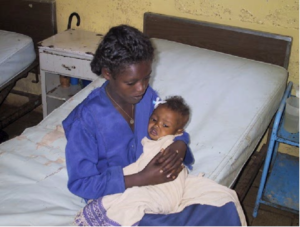Reasons for deaths in childbirth in low-income countries
 At Maternity Worldwide we recognise that the underlying and contributory causes of deaths in pregnancy and childbirth are complex and interlinked. Women and girls often have very low status in low-income countries and empowerment and education are central to enabling them to make their own decisions and allowing them to access maternal health and family planning services.
At Maternity Worldwide we recognise that the underlying and contributory causes of deaths in pregnancy and childbirth are complex and interlinked. Women and girls often have very low status in low-income countries and empowerment and education are central to enabling them to make their own decisions and allowing them to access maternal health and family planning services.
The risk of dying increases with the number of pregnancies a woman has in her lifetime. Risk is particularly high for those with four or more children.
Maternal haemorrhage is the third most likely cause of death for women in low income countries (World Health Organisation, 2008)
Where women live can also have a major impact on whether they can reach the level of maternal health services which they need. Many women in rural areas may live several hours away from the nearest health centre and transport may be limited or costly. There may be few roads or other barriers such as mountain ranges and rivers which make it very difficult to reach care.
Figures from the World Health Organisation (2008) show that maternal haemorrhage was the third most likely cause of death for women in low income countries (behind only HIV/AIDS and tuberculosis), accounting for 58,000 deaths. Unsafe abortions were the 5th most likely cause, resulting in a further 24,000 deaths.
The direct and measurable causes of deaths in pregnancy and childbirth are mainly:
- Severe bleeding (mostly after childbirth)
- Infections
- High blood pressure during pregnancy (pre-eclampsia and eclampsia)
- Unsafe abortions
These account for 80% of deaths.
How can we stop women and girls dying in pregnancy and childbirth?
Many deaths could be prevented through measures which are routine in wealthier countries such as the UK. Most deaths of women and girls in childbirth in developing countries are preventable and the health care needed to achieve this could be provided at relatively low cost. Empowerment of women and girls is vital in enabling them to access health care. Risks can be significantly reduced if problems in pregnancy can be picked up at an early stage and if women can deliver their babies in well-equipped health centres and hospitals with properly trained midwives and doctors to help.
Main measures which have been proven to help reduce maternal deaths area:
- Ensuring women have access to high quality ante natal care, ideally attending at least four times during pregnancy. This helps to pick up risks early on and can be used to ensure women receive the right level of care when giving birth.
- Having support from a skilled birth attendant (that is a suitably trained doctor, midwife or nurse) when giving birth
- When necessary, being able to have the baby in a well-equipped hospital or health centre
- Having an understanding of and voluntary access to modern family planning

